
This page is part of © FOTW Flags Of The World website
Dictionary of Vexillology: H (Hooch flag - Hussar Cut)
Last modified: 2016-03-29 by rob raeside
Keywords: vexillological terms |
Links: FOTW homepage |
search |
disclaimer and copyright |
write us |
mirrors
On this page:
HOOCH FLAG
In US military usage (particularly during the Vietnam War) the colloquial term for
a small, entirely unofficial, company or unit flag.
HOOKED-CROSS
See ‘swastika’.
![[honour point]](../images/v/vxt-d1864.gif)
Flag of the National Socialist Front, Sweden (fotw)
HORIZONTAL BICOLOUR
See ‘bicolour 1)’
(also ‘bicolour 2)’ and
‘over’).
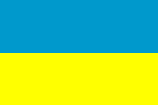
Civil Flag of Niederösterreich, Austria (fotw)
HORIZONTAL LATIN CROSS
See ‘off-centred cross2)’ and
‘Scandinavian cross’
(also ‘Latin Cross’ in ‘Appendix VIII:’).
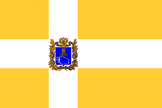
Flag of Stavropol, Russia (fotw)
HORIZONTAL MERIDIAN (or MEDIAN)
See ‘meridian’.

HORIZONTAL MULTI-STRIPE
See ‘multi-stripe’.
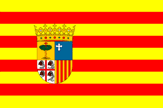
Flag of Aragon, Spain (fotw)
HORIZONTAL TRIBAND
See ‘triband 1)’ and ‘triband 2)’.
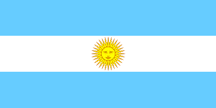
Flag of Argentina (fotw)
HORIZONTAL TRICOLOUR
See ‘tricolour 1)’ and ‘tricolour 2)’.
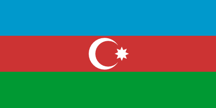
Flag of Azerbaijan (fotw)
HORNED
See ‘attired’.
![[Mettembert]](../images/v/vxt-d1383.gif)
Flag of Mettembert, Switzerland (fotw)
HORN OF PLENTY
See ‘cornucopia’.

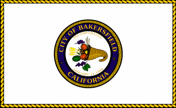
Seal and Flag of
Bakersfield, US (wikipedia and fotw)
HORSE-HEAD SHIELD
The term sometimes used to describe a shield of the decorative,
post-medieval type most often seen in Italian personal and civic heraldry but
see note below - a ‘horse-head shield’.
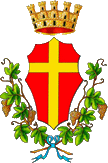
The Arms of Messina, Italy (ita24)
Please note that several of the terms giving shields a national identity, as well as those describing a specific type, are still in the process of
standardization, and that no consistent approach has thus far been identified.
HORSETAIL
A decoration for military flags, especially in China where it is usually red;
made of real or simulated horsehair and is almost certainly descended from a
Mongolian vexilloid (see also ‘tugh 1)’).
Please note that the standards of some former French
cavalry units (notably the Spahis originally raised in North Africa) were also
decorated by horsetails - see ‘toug’.
HORSETAIL STANDARD
See ‘tugh 1)’ and
‘toug’.
![[horsetail standards]](../images/v/vxt-d441.jpg)
Turkish Horsetail Standards
(worldimages)
HOUSE FLAG (or HOUSE PENNANT)
1) The distinguishing flag or pennant of a merchant marine company flown at sea by ships
owned or managed by that company, and from their headquarters on shore – a
shipping or shipping company house flag or pennant (see also ‘flags and funnels’,
‘logo’ and
‘pennant 2)’).
2) See ‘corporate flag’.
3) The personal flag of the owner of a pleasure vessel or home – a private
signal (see also ‘personal flag 2)’).
4) See ‘battle flag 2)’.
![[houseflag example]](../images/v/vxt-d585.gif)
![[houseflag example]](../images/v/vxt-d1838.gif)
![[houseflag example]](../images/v/vxt-d1140.gif)
![[houseflag example]](../images/v/vxt-d585b.gif)
From left: Black Diamond Co, Canada (fotw);
Green and Co., US (fotw);
Alaska Steamship Co, US (fotw); White Star Line, UK (fotw)
HOUSE MARK (or HOUSE BRAND)
In Continental usage the term, and a translation of the German hausmarken or
housmarke, that may be used to describe the symbol or symbols used by non-armigerous
tradesmen in place of a coat of arms – a house brand or merchant mark (see also
‘armigerous’,
‘coat of arms 2)’ and
‘mark 2)’)
![[house mark example]](../images/v/vxt-d2043.gif)
![[house mark example]](../images/v/vxt-d2044a.gif)
![[house mark example]](../images/v/vxt-d2044b.gif)
![[house mark example]](../images/v/vxt-d2045.gif)
![[house mark example]](../images/v/vxt-d2046.gif)
![[house mark example]](../images/v/vxt-d2046a.gif)
Flag of Hiddensee Island, Germany (fotw); Arms and Banner of
Bobenheim am Berg Germany (Wiki and fotw); Arms of
Grantschen, Germany (Wiki); Banner
Arms of
Lamprechtshausen, Austria (fotw & Wikipedia).
HOUSEWIMPEL
See ‘house flag 1)’.
![[house pennant example]](../images/v/vxt-d1421.gif)
Housewinpel/House Pennant of The Blue Star Line, UK (fotw)
Please note that the correct term in English language vexillology
is house pennant - see ‘wimpel’ and following note.
HURT
The heraldic term for a blue disc – a roundel azure (see also
‘bezant’,
‘plates’,
‘roundel 3)’ and
‘torteau’).
![[hurt example]](../images/v/vxt-d941a.gif)
![[hurt example]](../images/v/vxt-d941b.gif)
![[hurt example]](../images/v/vxt-d941c.gif)
Hurt example, Flag of Lenzburg, Switzerland (fotw); Flag of Salisbury, Rhodesia (Zimbabwe) 1939 – 1982 (fotw)
Please note that in strict English heraldic usage this term should only be applied when the charge described in blue (“azure”) – see ‘tinctures’ in ‘appendix III’.
HUSBAND PENNANT (or WIMPEL)
In Scandinavian (particularly Finnish) usage the colloquial term, and a direct translation
of the Finnish “isännänviiri” or Swedish “husbondsvimpel”, used for a provincial wimpel – see
‘provincial wimpel’
(also ‘wimpel’).
![[husband flag example]](../images/v/vxt-d1096.gif)
Husband Pennant/Provincial Wimpel of Kainuu, Finland (fotw)
HUSSAR CUT
A variation of the swallow-tail in which the cut in the fly of the flag is
shaped by several curves, and was formerly typical of the flags used by
Prussian later German
cavalry regiments (see also
‘descate’,
‘palm’,
‘guidon 2)’,
‘indentation(s)’, ‘rounded swallow-tail’ and
‘swallow-tail(ed)’).
![[Hussar cut example]](../images/v/vxt-d1508.gif)
![[Hussar cut example]](../images/v/vxt-d2692.gif)
![[Hussar cut example]](../images/v/vxt-d2693.gif)
2nd Hussar Regiment, Prussia c1740 (Klaus-Michael Schneider);
Cavalry Guidons, Hamburg 1709 (fotw)
Introduction | Table of Contents
| Index of Terms | Previous Page | Next Page
![[honour point]](../images/v/vxt-d1864.gif)

![[honour point]](../images/v/vxt-d1864.gif)




![[Mettembert]](../images/v/vxt-d1383.gif)



![]()
![[houseflag example]](../images/v/vxt-d585.gif)
![[houseflag example]](../images/v/vxt-d1838.gif)
![[houseflag example]](../images/v/vxt-d1140.gif)
![[houseflag example]](../images/v/vxt-d585b.gif)
![[house mark example]](../images/v/vxt-d2043.gif)
![[house mark example]](../images/v/vxt-d2044a.gif)
![[house mark example]](../images/v/vxt-d2044b.gif)
![[house mark example]](../images/v/vxt-d2045.gif)
![[house mark example]](../images/v/vxt-d2046.gif)
![[house mark example]](../images/v/vxt-d2046a.gif)
![[house pennant example]](../images/v/vxt-d1421.gif)
![[hurt example]](../images/v/vxt-d941a.gif)
![[hurt example]](../images/v/vxt-d941b.gif)
![[hurt example]](../images/v/vxt-d941c.gif)
![[Hussar cut example]](../images/v/vxt-d1508.gif)
![[Hussar cut example]](../images/v/vxt-d2692.gif)
![[Hussar cut example]](../images/v/vxt-d2693.gif)